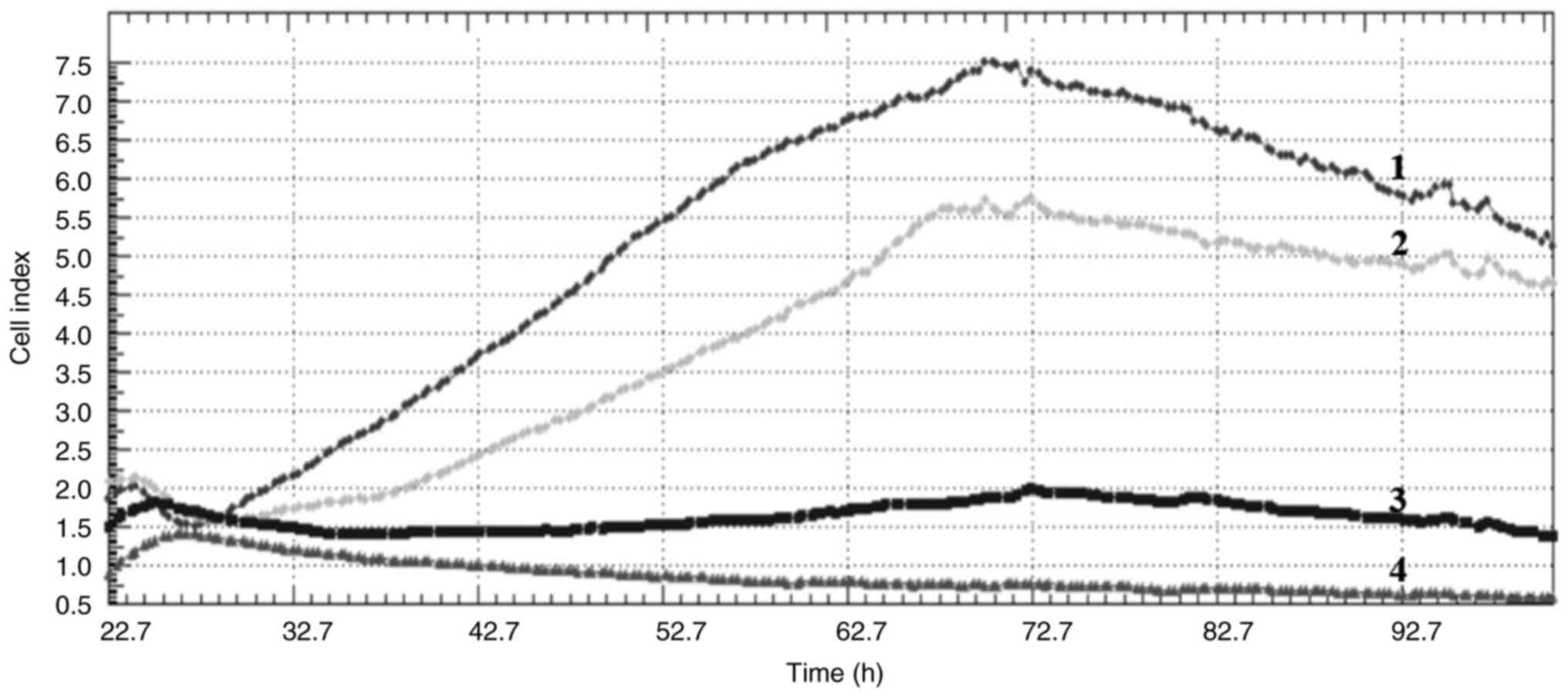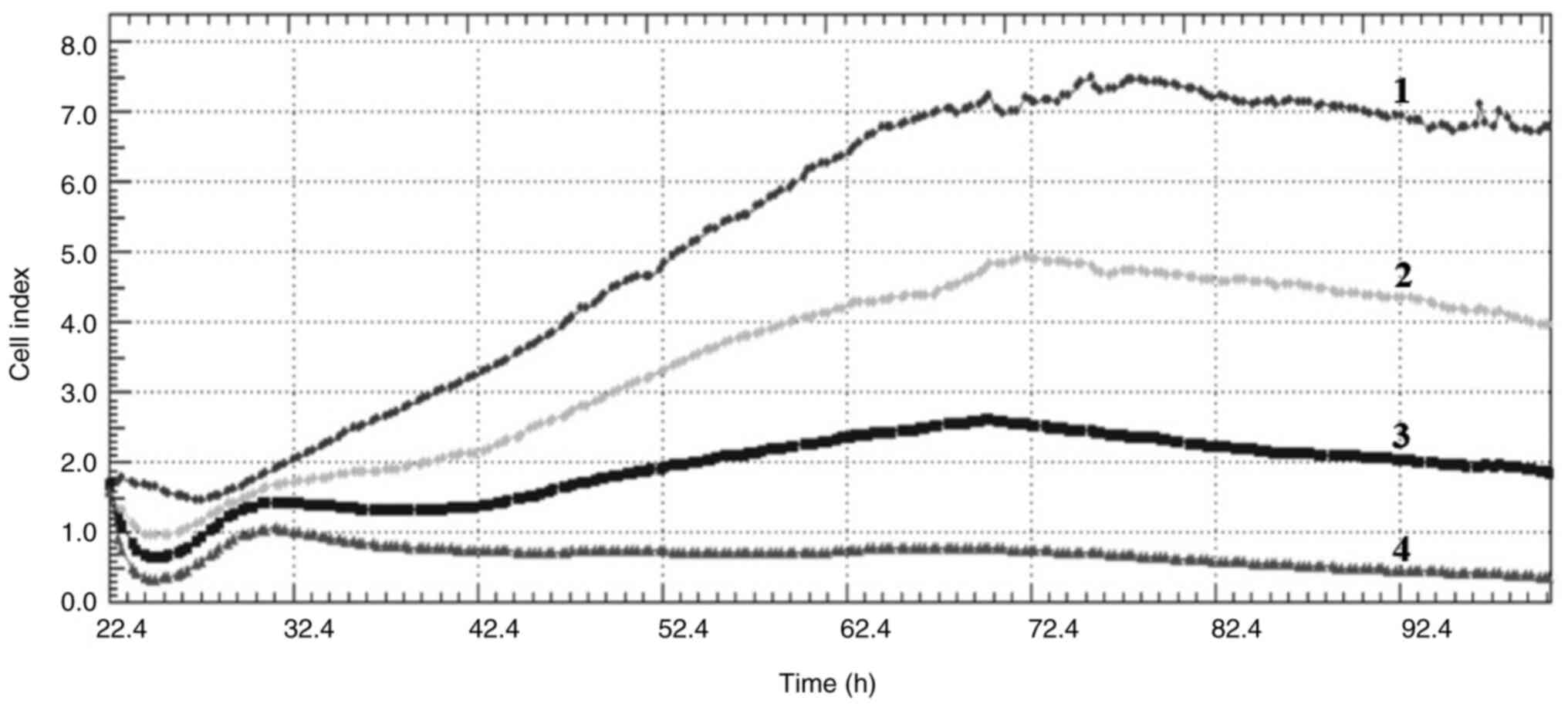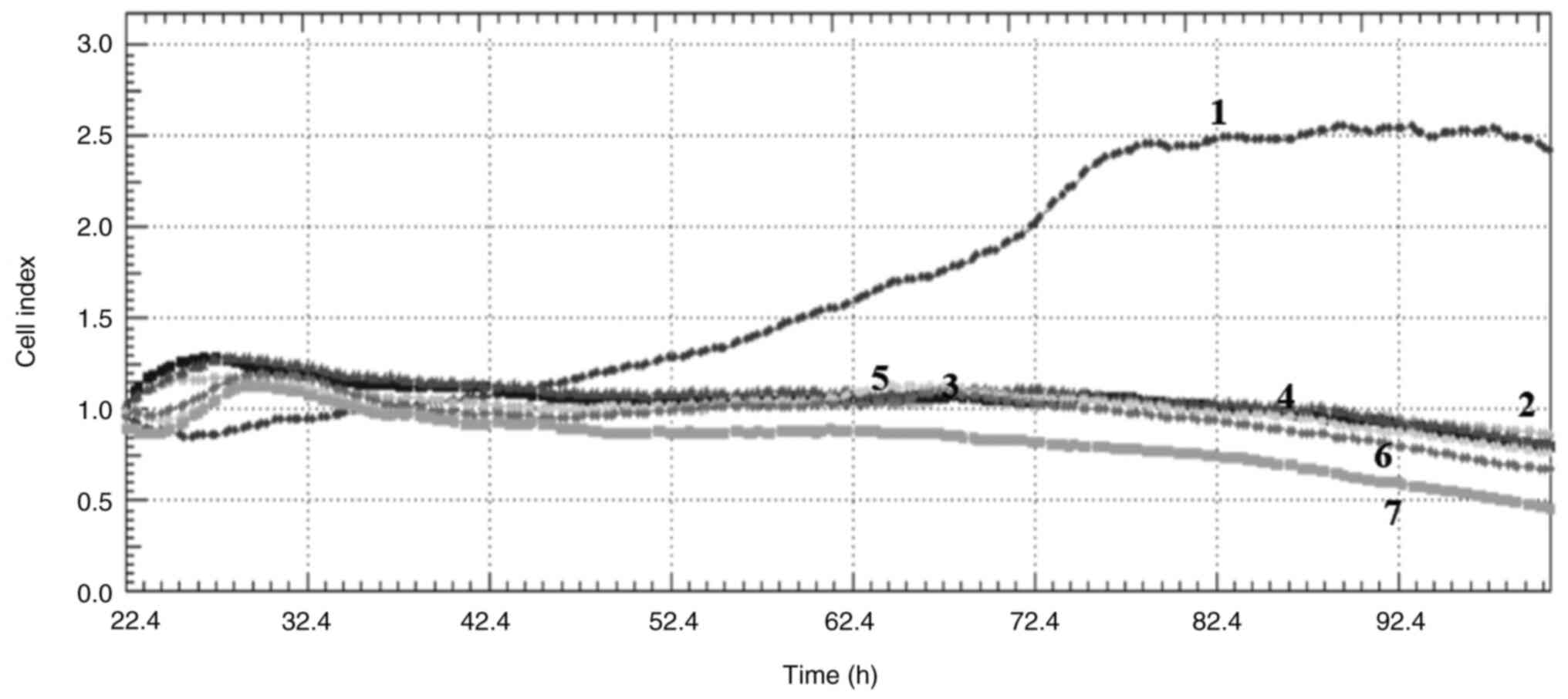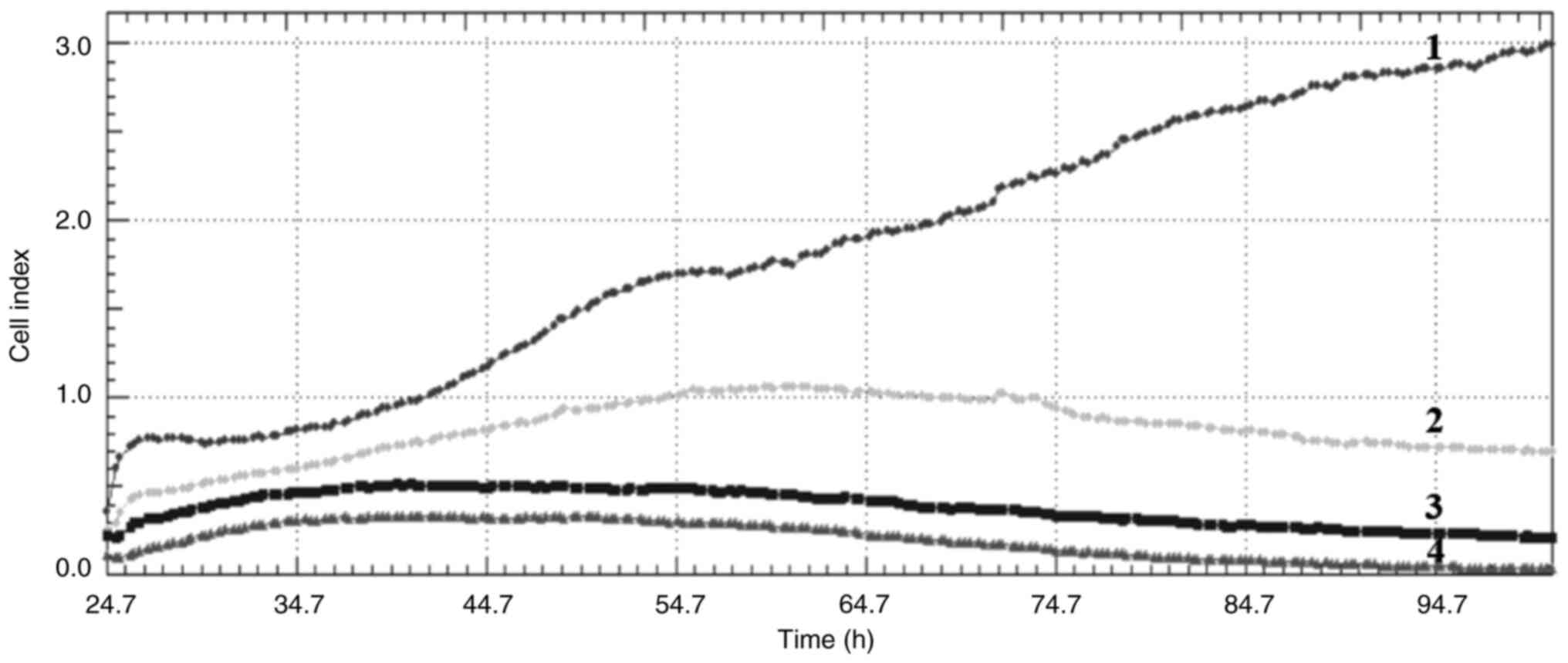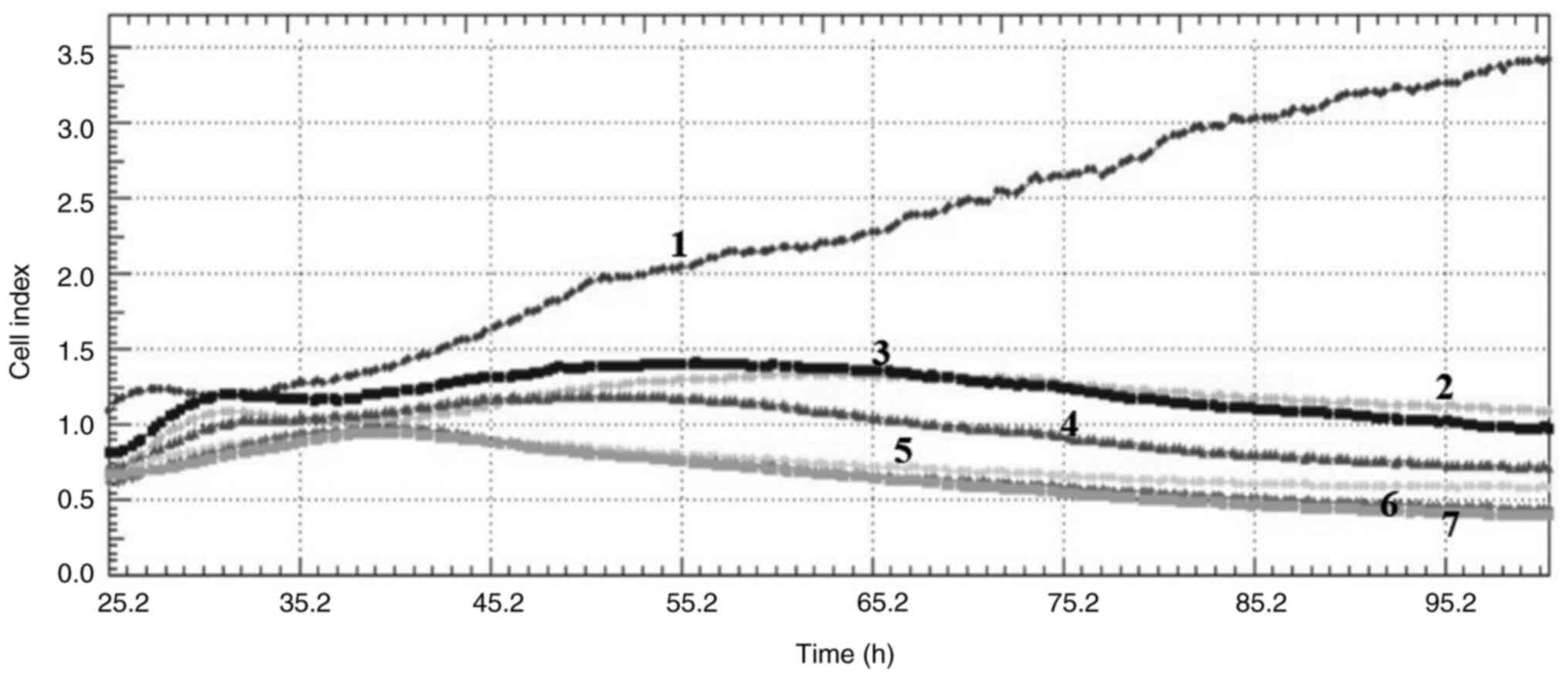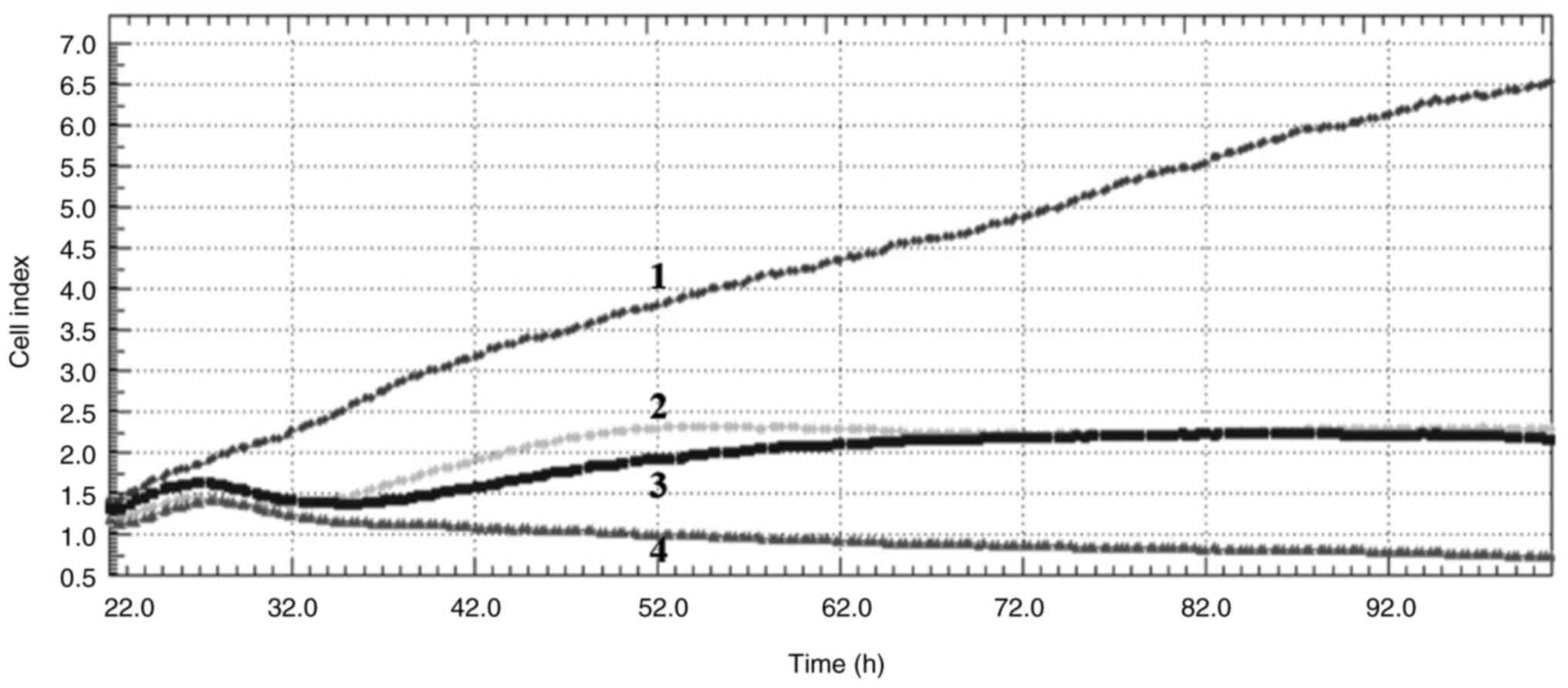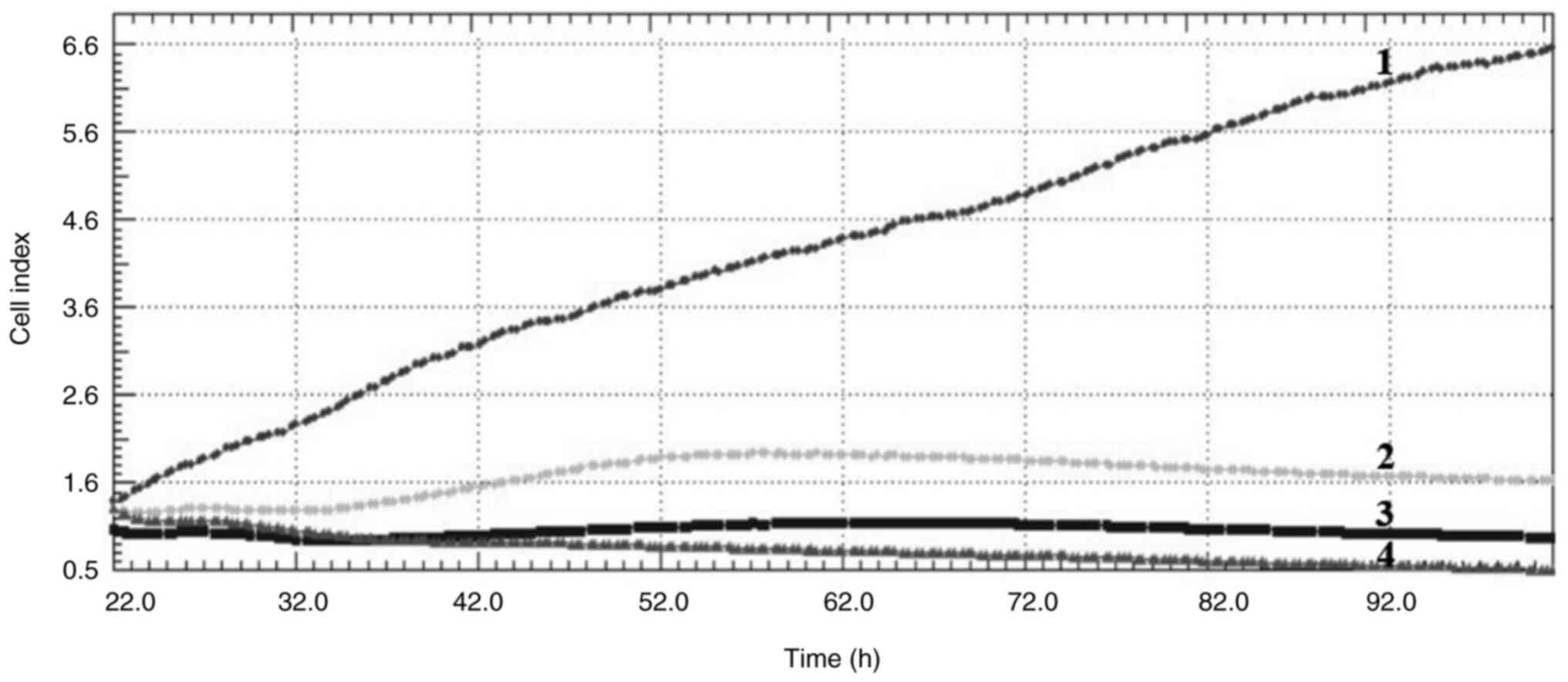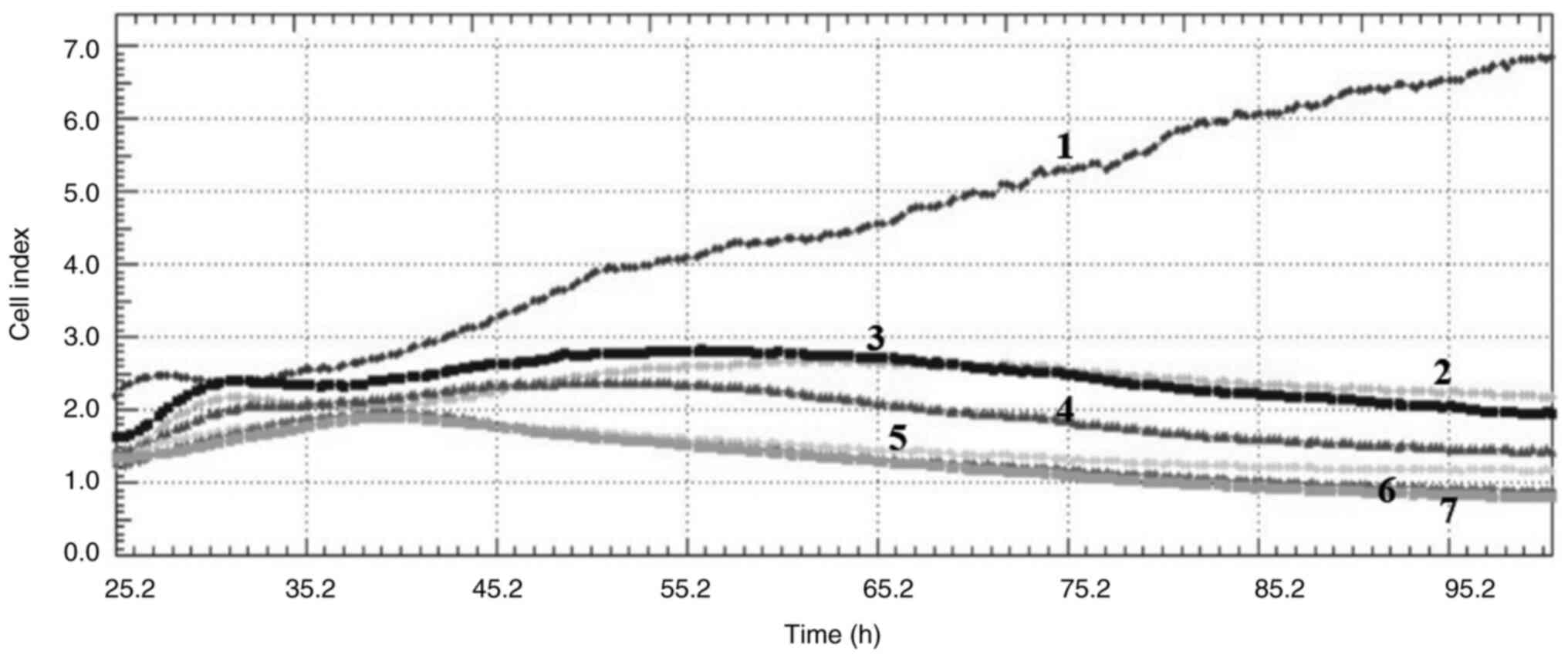|
1
|
Arya GC, Kaur K and Jaitak V: Isoxazole
derivatives as anticancer agent: A review on synthetic strategies,
mechanism of action and SAR studies. Eur J Med Chem.
221:1135112021. View Article : Google Scholar : PubMed/NCBI
|
|
2
|
Siegel RL, Miller KD and Jemal A: Cancer
statistics, 2019. CA Cancer J Clin. 69:7–34. 2019. View Article : Google Scholar : PubMed/NCBI
|
|
3
|
Yue W, Yager JD, Wang JP, Jupe ER and
Santen RJ: Estrogen receptor-dependent and independent mechanisms
of breast cancer carcinogenesis. Steroids. 78:161–170. 2013.
View Article : Google Scholar : PubMed/NCBI
|
|
4
|
İnce E and Orhan HG: Estrogen-Induced
Breast Cancer, Therapeutical Approaches and the Role of Melatonin
in Treatment. HUJPHARM. 39:113–128. 2019.(In Türkiye).
|
|
5
|
Sørlie T, Perou CM, Tibshirani R, Aas T,
Geisler S, Johnsen H, Hastie T, Eisen MB, van de Rijn M, Jeffrey
SS, et al: Gene expression patterns of breast carcinomas
distinguish tumor subclasses with clinical implications. Proc Natl
Acad Sci USA. 98:10869–10874. 2001. View Article : Google Scholar : PubMed/NCBI
|
|
6
|
Herschkowitz JI, Simin K, Weigman VJ,
Mikaelian I, Usary J, Hu Z, Rasmussen KE, Jones LP, Assefnia S,
Chandrasekharan S, et al: Identification of conserved gene
expression features between murine mammary carcinoma models and
human breast tumors. Genome Biol. 8:R762007. View Article : Google Scholar : PubMed/NCBI
|
|
7
|
Huang E, Cheng SH, Dressman H, Pittman J,
Tsou MH, Horng CF, Bild A, Iversen ES, Liao M, Chen CM, et al: Gene
expression predictors of breast cancer outcomes. Lancet.
361:1590–1596. 2003. View Article : Google Scholar : PubMed/NCBI
|
|
8
|
Sørlie T, Tibshirani R, Parker J, Hastie
T, Marron JS, Nobel A, Deng S, Johnsen H, Pesich R, Geisler S, et
al: Repeated observation of breast tumor subtypes in independent
gene expression data sets. Proc Natl Acad Sci USA. 100:8418–8423.
2003. View Article : Google Scholar : PubMed/NCBI
|
|
9
|
Peng JH, Zhang X, Song JL, Ran L, Luo R,
Li HY and Wang YH: Neoadjuvant chemotherapy reduces the expression
rates of ER, PR, HER2, Ki67 and P53 of invasive ductal carcinoma.
Medicine (Baltimore). 98:e135542019. View Article : Google Scholar : PubMed/NCBI
|
|
10
|
Barnes DM and Hanby AM: Oestrogen and
progesterone receptors in breast cancer: past, present and future.
Histopathology. 38:271–274. 2001. View Article : Google Scholar : PubMed/NCBI
|
|
11
|
Akoz G, Diniz G, Ekmekci S, Ekin ZY and
Uncel M: Evaluation of human epididymal secretory protein 4
expression according to the molecular subtypes (luminal A, luminal
B, human epidermal growth factor receptor 2-positive,
triple-negative) of breast cancer. Indian J Pathol Microbiol.
61:323–329. 2018. View Article : Google Scholar : PubMed/NCBI
|
|
12
|
Orrantia-Borunda E, Anchondo-Nuñez P,
Acuña-Aguilar LE, Gómez-Valles FO, Ramírez-Valdespino CA and
Mayrovitz HN: Subtypes of Breast Cancer. Exon Publications 31–42;
2022, View Article : Google Scholar
|
|
13
|
Barker S: Anti-estrogens in the treatment
of breast cancer: current status and future directions. Curr Opin
Investig Drugs. 4:652–657. 2003.PubMed/NCBI
|
|
14
|
Wong ZW and Ellis MJ: First-line endocrine
treatment of breast cancer: Aromatase inhibitor or antioestrogen?
Br J Cancer. 90:20–25. 2004. View Article : Google Scholar : PubMed/NCBI
|
|
15
|
Kumar P and Aggarwal R: An overview of
triple-negative breast cancer. Arch Gynecol Obstet. 293:247–269.
2016. View Article : Google Scholar : PubMed/NCBI
|
|
16
|
Hong S, Fang W, Liang W, Yan Y, Zhou T,
Qin T, Wu X, Ma Y, Zhao Y, Yang Y, et al: Risk of treatment-related
deaths with vascular endothelial growth factor receptor tyrosine
kinase inhibitors: A meta-analysis of 41 randomized controlled
trials. Onco Targets Ther. 7:1851–1867. 2014. View Article : Google Scholar : PubMed/NCBI
|
|
17
|
Gurkan-Alp SA and Bozca F: Tirozin kinaz
enzim inhibitörü yeni bileşikler ve yapı aktivite ilişkilerinin
değerlendirilmesi. FABAD J Pharm Sci. 44:65–78. 2019.
|
|
18
|
De Bono JS and Yap TA: c-MET: An exciting
new target for anticancer therapy. Ther Adv Med Oncol. 3 (Suppl.
S1):S3–S5. 2011. View Article : Google Scholar : PubMed/NCBI
|
|
19
|
Gastaldi S, Comoglio PM and Trusolino L:
The Met oncogene and basal-like breast cancer: Another culprit to
watch out for? Breast Cancer Res. 12:2082010. View Article : Google Scholar : PubMed/NCBI
|
|
20
|
Ho-Yen CM, Jones JL and Kermorgant S: The
clinical and functional significance of c-Met in breast cancer: A
review. Breast Cancer Res. 17:522015. View Article : Google Scholar : PubMed/NCBI
|
|
21
|
Mino-Kenudson M, Chirieac LR, Law K,
Hornick JL, Lindeman N, Mark EJ, Cohen DW, Johnson BE, Jänne PA,
Iafrate AJ and Rodig SJ: A novel highly sensitive antibody allows
for the routine detection of ALK rearranged lung adenocarcinomas by
standard immunohistochemistry. Clin Cancer Res. 16:1561–1571. 2010.
View Article : Google Scholar : PubMed/NCBI
|
|
22
|
Hagland HR and Søreide K: Cellular
metabolism in colorectal carcinogenesis: Influence of lifestyle,
gut microbiome and metabolic pathways. Cancer Lett. 356:273–280.
2015. View Article : Google Scholar : PubMed/NCBI
|
|
23
|
Hamer HM, Jonkers D, Venema K, Vanhoutvin
S, Troost FJ and Brummer RJ: Review article: The role of butyrate
on colonic function. Aliment Pharmacol Ther. 27:104–119. 2008.
View Article : Google Scholar : PubMed/NCBI
|
|
24
|
Taylor MA, Khathayer F and Ray SK:
Quercetin and sodium butyrate synergistically increase apoptosis in
rat C6 and Human T98G glioblastoma cells through inhibition of
autophagy. Neurochem Res. 44:1715–1725. 2019. View Article : Google Scholar : PubMed/NCBI
|
|
25
|
Egler V, Korur S, Failly M, Boulay JL,
Imber R, Lino MM and Merlo A: Histone deacetylase inhibition and
blockade of the glycolytic pathway synergistically induce
glioblastoma cell death. Clin Cancer Res. 14:3132–3140. 2008.
View Article : Google Scholar : PubMed/NCBI
|
|
26
|
Pulat E and Topçul MR: Effects of combined
use of ribociclib with PARP1 inhibitor on cell kinetics in breast
cancer. Oncol Lett. 27:2432024. View Article : Google Scholar : PubMed/NCBI
|
|
27
|
Baykara O: Kanser Tedavisinde Güncel
YaklaşImlar. Balıkesir Sağlık Bilimleri Dergisi. 5:154–165.
2016.(In Türkiye).
|
|
28
|
Palmer AC and Sorger PK: Combination
cancer therapy can confer benefit via patient-to-patient
variability without drug additivity or synergy. Cell.
171:1678–1691.e13. 2017. View Article : Google Scholar : PubMed/NCBI
|
|
29
|
Lee JH and Nan A: Combination drug
delivery approaches in metastatic breast cancer. J Drug Deliv.
2012:9153752012. View Article : Google Scholar : PubMed/NCBI
|
|
30
|
Takeuchi K and Ito F: Receptor tyrosine
kinases and targeted cancer therapeutics. Biol Pharm Bull.
34:1774–1780. 2011. View Article : Google Scholar : PubMed/NCBI
|
|
31
|
Zhu K, Kong X, Zhao D, Liang Z and Luo C:
c-MET kinase inhibitors: A patent review (2011–2013). Expert Opin
Ther Pat. 24:217–230. 2014. View Article : Google Scholar : PubMed/NCBI
|
|
32
|
Linklater ES, Tovar EA, Essenburg CJ,
Turner L, Madaj Z, Winn ME, Melnik MK, Korkaya H, Maroun CR,
Christensen JG, et al: Targeting MET and EGFR crosstalk signaling
in triple-negative breast cancers. Oncotarget. 7:69903–69915. 2016.
View Article : Google Scholar : PubMed/NCBI
|
|
33
|
Blumenschein GR Jr, Mills GB and
Gonzalez-Angulo AM: Targeting the hepatocyte growth factor-cMET
axis in cancer therapy. J Clin Oncol. 30:3287–3296. 2012.
View Article : Google Scholar : PubMed/NCBI
|
|
34
|
Boccaccio C and Comoglio PM: MET, a driver
of invasive growth and cancer clonal evolution under therapeutic
pressure. Curr Opin Cell Biol. 31:98–105. 2014. View Article : Google Scholar : PubMed/NCBI
|
|
35
|
Gonzalez-Angulo AM, Chen H, Karuturi MS,
Chavez-MacGregor M, Tsavachidis S, Meric-Bernstam F, Do KA,
Hortobagyi GN, Thompson PA, Mills GB, et al: Frequency of
mesenchymal-epithelial transition factor gene (MET) and the
catalytic subunit of phosphoinositide-3-kinase (PIK3CA) copy number
elevation and correlation with outcome in patients with early stage
breast cancer. Cancer. 119:7–15. 2013. View Article : Google Scholar : PubMed/NCBI
|
|
36
|
Inanc M, Ozkan M, Karaca H, Berk V,
Bozkurt O, Duran AO, Ozaslan E, Akgun H, Tekelioglu F and Elmali F:
Cytokeratin 5/6, c-Met expressions, and PTEN loss prognostic
indicators in triple-negative breast cancer. Med Oncol. 31:8012014.
View Article : Google Scholar : PubMed/NCBI
|
|
37
|
Yan S, Jiao X, Zou H and Li K: Prognostic
significance of c-Met in breast cancer: A metaanalysis of 6010
cases. Diagn Pathol. 10:622015. View Article : Google Scholar : PubMed/NCBI
|
|
38
|
Ponzo MG, Lesurf R, Petkiewicz S, O'Malley
FP, Pinnaduwage D, Andrulis IL, Bull SB, Chughtai N, Zuo D,
Souleimanova M, et al: Met induces mammary tumors with diverse
histologies and is associated with poor outcome and human basal
breast cancer. Proc Natl Acad Sci USA. 106:12903–12908. 2009.
View Article : Google Scholar : PubMed/NCBI
|
|
39
|
Graveel CR, DeGroot JD, Su Y, Koeman J,
Dykema K, Leung S, Snider J, Davies SR, Swiatek PJ, Cottingham S,
et al: Met induces diverse mammary carcinomas in mice and is
associated with human basal breast cancer. Proc Natl Acad Sci USA.
106:12909–12914. 2009. View Article : Google Scholar : PubMed/NCBI
|
|
40
|
Sierra JR and Tsao MS: c-MET as a
potential therapeutic target and biomarker in cancer. Ther Adv Med
Oncol 3 (1 suppl). S21–S35. 2011. View Article : Google Scholar : PubMed/NCBI
|
|
41
|
Huang X, Li E, Shen E, Wang X, Tang T,
Zhang X, Xu J, Tang Z, Guo C, Bai X and Liang T: Targeting the
HGF/MET axis in cancer therapy: Challenges in resistance and
opportunities for improvement. Front Cell Dev Biol. 8:1522020.
View Article : Google Scholar : PubMed/NCBI
|
|
42
|
Goździk-Spychalska J, Szyszka-Barth K,
Spychalski Ł, Ramlau K, Wójtowicz J, Batura-Gabryel H and Ramlau R:
C-MET inhibitors in the treatment of lung cancer. Curr Treat
Options Oncol. 15:670–682. 2014. View Article : Google Scholar : PubMed/NCBI
|
|
43
|
Kwak EL, Bang YJ, Camidge DR, Shaw AT,
Solomon B, Maki RG, Ou SH, Dezube BJ, Jänne PA, Costa DB, et al:
Anaplastic lymphoma kinase inhibition in non-small-cell lung
cancer. N Engl J Med. 363:1693–1703. 2010. View Article : Google Scholar : PubMed/NCBI
|
|
44
|
Cui JJ, Tran-Dubé M, Shen H, Nambu M, Kung
PP, Pairish M, Jia L, Meng J, Funk L, Botrous I, et al: Structure
based drug design of crizotinib (PF02341066), a potent and
selective dual inhibitor of mesenchymal-epithelial transition
factor (c-MET) kinase and anaplastic lymphoma kinase (ALK). J Med
Chem. 54:6342–6363. 2011. View Article : Google Scholar : PubMed/NCBI
|
|
45
|
Lawrence RE and Salgia R: MET molecular
mechanisms and therapies in lung cancer. Cell Adh Migr. 4:146–152.
2010. View Article : Google Scholar : PubMed/NCBI
|
|
46
|
Ayoub NM, Al-Shami KM, Alqudah MA and
Mhaidat NM: Crizotinib, a MeT inhibitor, inhibits growth,
migration, and invasion of breast cancer cells in vitro and
synergizes with chemotherapeutic agents. Onco Targets Ther.
10:4869–4883. 2017. View Article : Google Scholar : PubMed/NCBI
|
|
47
|
Du Y, Yamaguchi H, Wei Y, Hsu JL, Wang HL,
Hsu YH, Lin WC, Yu WH, Leonard PG, Lee GR IV, et al: Blocking
c-Met-mediated PARP1 phosphorylation enhances anti-tumor effects of
PARP inhibitors. Nat Med. 22:194–201. 2016. View Article : Google Scholar : PubMed/NCBI
|
|
48
|
Raghav KP, Gonzalez-Angulo AM and
Blumenschein GR Jr: Role of HGF/MET axis in resistance of lung
cancer to contemporary management. Transl Lung Cancer Res.
1:179–193. 2012.PubMed/NCBI
|
|
49
|
Wang J and Cheng JX: c-Met inhibition
enhances chemosensitivity of human ovarian cancer cells. Clin Exp
Pharmacol Physiol. 44:79–87. 2017. View Article : Google Scholar : PubMed/NCBI
|
|
50
|
Li E, Hu Z, Sun Y, Zhou Q, Yang B, Zhang Z
and Cao W: Small molecule inhibitor of c-Met (PHA665752) suppresses
the growth of ovarian cancer cells and reverses cisplatin
resistance. Tumour Biol. 37:7843–7852. 2016. View Article : Google Scholar : PubMed/NCBI
|
|
51
|
Natoni F, Diolordi L, Santoni C and
Gilardini Montani MS: Sodium butyrate sensitises human pancreatic
cancer cells to both the intrinsic and the extrinsic apoptotic
pathways. Biochim Biophys Acta. 1745:318–329. 2005. View Article : Google Scholar : PubMed/NCBI
|
|
52
|
Salimi V, Shabani M, Nourbakhsh M and
Tavakoli-Yaraki M: Involvement of 15-lipoxygenase-1 in the
regulation of breast cancer cell death induced by sodium butyrate.
Cytotechnology. 68:2519–2528. 2016. View Article : Google Scholar : PubMed/NCBI
|
|
53
|
Coradini D, Biffi A, Costa A, Pellizzaro
C, Pirronello E and Di Fronzo G: Effect of sodium butyrate on human
breast cancer cell lines. Cell Prolif. 30:149–159. 1997. View Article : Google Scholar : PubMed/NCBI
|
|
54
|
Stockhammera P, Hoc CSL, Hegedusa L, Lotzd
G, Molnárd E, Bankfalvie A, Herold T, Kalbourtzis S, Ploenes T,
Eberhardt WEE, et al: HDAC inhibition synergizes with ALK
inhibitors to overcome resistance in a novel ALK mutated lung
adenocarcinoma model. Lung Cancer. 144:20–29. 2020. View Article : Google Scholar : PubMed/NCBI
|
|
55
|
Fukuda K, Takeuchi S, Katayama R, Nanjo S,
Yamada T, Suzuki T, et al: HDAC Inhibition Overcomes
Crizotinib-Resistance by Mesenchymal-Epithelial Transition (MET) in
EML4-ALK Lung Cancer Cells. J Thorac Oncol. 12:S382–S383. 2017.
View Article : Google Scholar
|



